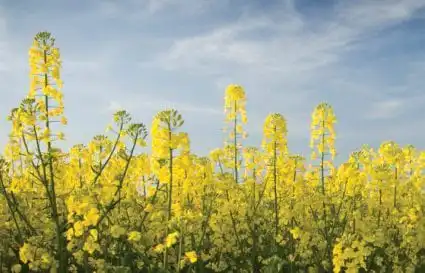This year’s Plant Breeding and Genetics Award winner says learning to put aside distractions has been the key to a successful career in plant breeding.
Over a career that has spanned three decades, Van Ripley of Turtleford, Sask., has been intent on pioneering major improvements in one of Canada’s signature crops — canola.
Currently the North American canola R&D lead for Nuseed, he has built a canola hybrid strategy and pipeline to fit the needs of Canadian farmers and industry. In 2020, Nuseed was able to launch the first in a series of canola products into the Canadian market thanks in no small part to Ripley’s vast knowledge of canola. He has also developed a pipeline of Nuseed canola products with multiple oil profiles to meet the needs of industry and growers.
That’s just the tip of the iceberg for the 59-year-old, whose colleagues consider him a visionary who helped make canola what it is today — one of Canada’s top crops grown by 43,000 Canadian farmers who produce about 20 million tonnes of canola annually, according to Canola Council of Canada statistics.
Ripley’s love of plant breeding began in childhood, spending time on his grandparents’ Nova Scotia farm and gardening with his parents.
“I was eight or 10 or something like that, and I remember collecting seeds from our garden. We lived in the country at that time, and I remember just collecting seeds and saying to my parents that I was going to keep them so we could use them next year. I was just so thrilled with the idea that I could just keep these seeds and then I could grow them again next year,” Ripley says.
“Once I got into university and I started taking plant breeding courses, I just found it extremely fascinating that you could actually select material and make crosses between individual plants and develop something totally new.”
His academic career began in the 1980s at the University of Guelph, which is where he stayed right up until completing his PhD in crop breeding in 1995 under the supervision of Wally Beversdorf. It was Beversdorf who recruited the young Ripley to work with him on what would be the ushering in of a new era for canola.
“While working on my PhD, pollination control systems were just coming into play. Wally was the chairman of the university’s crop science department at that time, and he was doing a lot of work on pollination control systems, which ultimately allowed us to produce canola hybrids,” Ripley recalls.
“He was doing some work with a small company at that time called Plant Genetics Systems, or PGS, which was developing the LibertyLink system. It was fascinating because not only were we working on the new pollination control systems and trying to decide which one would work best for canola long-term, but then also thinking about how to transition an open pollinated crop to a hybrid crop.”

New Ways of Thinking
Doing that required a new way of thinking about plant breeding, Ripley says.
As excited as Ripley was about working with canola, he was also a pragmatist.
“As a young plant breeder at that time, I just wanted to get a job after graduation, and there weren’t really a lot of plant breeding positions available in Ontario at that time. Canola was really expanding in Western Canada, so it gave me an opportunity to start my career.”
That career began in the 1990s at Aventis CropScience in Saskatoon, where he worked as a canola breeder running a full breeding program for development of Liberty resistant canola varieties. He worked closely with Agriculture and Agri-Food Canada (AAFC) researchers to develop and introduce the first Liberty resistant variety, Innovator, to the market in 1995.
“That’s my top memory of working in this industry. That team involved some very well-known breeders like the late Gerhard Rakow from AAFC. Herbicide tolerant canola really was a game changer for the industry. It really allowed for the expansion of the industry and also changed the way agriculture is being done in Western Canada,” Ripley says.
In 2001 he would move on to the AAFC Saskatoon Research Centre, working to develop hybrid Brassica juncea canola germplasm for the Canadian market and initiating a program to develop high oil/high glucosinolate B. juncea for the biodiesel market.
“We were successful in getting the Ogura pollination control system into our germplasm, which was a big deal,” he says.
Ogura cytoplasmic male sterility has been used to develop high-yielding hybrids in regular commodity canola, and was incorporated into B. juncea with great success. The Ogura system has since been used to develop mustard quality juncea hybrids at AAFC.
“Even though I didn’t personally accomplish the introduction of those commercial mustard hybrids, I do feel that it was an accomplishment to get the system into that species so that other breeders could use it and introduce excellent products like that.”
In 2006 he arrived at Dow AgroSciences, helping develop Nexera hybrids. He produced the first clubroot resistant Clearfield hybrid into the market.
“What I was able to do there really represented significant improvements in yield performance of high oleic low-linolenic material and allowed the company to grow their acreage and market share. We showed that just because something is high oleic low-linolenic doesn’t mean that you necessarily have to give up on performance compared to traditional fatty acid profile canola.”
According to Steve Thompson, who served as plant breeding and genetics leader for the company’s seed division at the time, Ripley’s approach to plant breeding at Dow was likely the “most scientific” he had ever seen.
“Van was at the absolute top of his game in terms of not only canola breeding but as a scientist in general. A lot of plant breeders tend to get their kudos and accomplishments documented through plant protection certificates and sometimes patents, but not so much scientific journal articles. If you look at Van’s CV, you’ll see quite the extensive list of scientific journal articles,” Thompson says.
“He’s very involved in things like using wild relatives to improve the canola genetic base. Van really built our canola breeding effort in Canada by hiring some great scientists and mentoring many young ones. He was always giving them just enough input to help them, but never got in their way.”
In 2018 Ripley arrived at Nuseed as the North American Canola R&D Lead.
“Van not only has tremendous science knowledge, but he also understands the marketplace. That can be a rare combination, knowing what both growers need and what the end user wants. He has a complete view of the canola industry and how as a breeder you can combine all the attributes that are required by growers and end users and commodity traders and try and get them into that one single plant,” says Roger Rotariu, North American marketing lead for Nuseed.
As he eyes retirement, Ripley has taken to expanding his breeding repertoire beyond oilseeds and into the realm of hot pepper breeding. As a hobby, he’s attempting to breed early-season hot chili peppers adapted to Western Canada.
“That shows Van’s vision for both the science and the market. I keep teasing him that I want in on his side project, because Canadians love hot peppers but it’s so hard to grow them in the West. If he succeeds it could lead to a whole new industry,” Rotariu adds.
Best is Yet to Come
Despite the strides made in canola breeding, Ripley says the best is yet to come as the crop evolves.
“We are very much at the early stages with canola in terms of its potential. When you look at it, hybrids really have not been in the marketplace for that long. As we continue breeding hybrids and better understand the drivers of heterosis, a big priority is going to be a significant ongoing increase in yield,” he says.
“The other thing I think that’s going to have a major impact is the application of modern tools of plant breeding, like gene editing. It will help solve some of the things we have not been able to fully crack, like sclerotinia resistance. Aside from that, there’s also the whole suite of tools around things like genomic prediction. We can use whole genome sequencing and sequence-based selection methods to allow us to really enhance the yield potential of canola.”
Predictive breeding allows for significant improvements in yield, but those tools can be applied to any other traits that are controlled by multiple genes, he adds. He predicts significant improvements in the future in canola quality, like increased oil content and improvements in protein production.
One caveat, he says, is that industry needs to get consumers to accept these new technologies.
“Right now, for instance, we know that the European Union still considers a lot of these novel technologies to be equivalent to GM in terms of regulation. It all comes down to consumer concern over genetic manipulation. We really have to not only think about it from a scientific point of view or a commercial point of view, but from a social science point of view. How do we bring consumers along with us in terms of an understanding that this is just the next phase of plant breeding?”
Hear Van on an upcoming webinar talking about his experience with canola! Register at https://attendee.gotowebinar.com/register/7706105777491771152?source=SW











